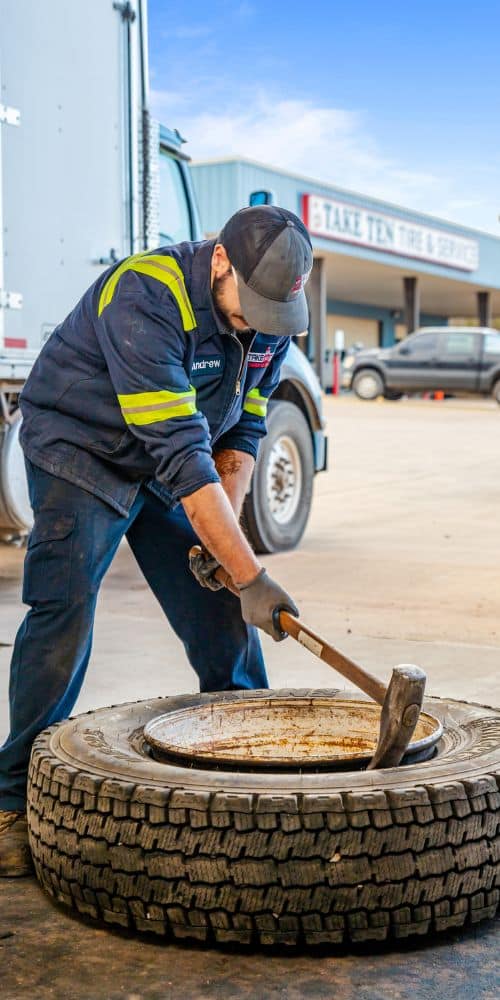Tire Service: The Influence of Climate Condition
When it comes to making sure ideal performance and security on the roadway, understanding the impact of weather problems on tire service is important. GMC Tire Service. In this conversation, we will certainly discover the elaborate partnership between climate problems and tire service, dropping light on the importance of weather-specific tire upkeep practices and factors to consider.
Warm and Tire Performance
When revealed to high temperature levels, tires experience changes in efficiency that can dramatically impact automobile safety and security and handling. The warm created from prolonged driving or hot weather problems triggers the tire rubber to soften, leading to reduced walk life and enhanced wear.

Cold Climate Effects
Cold weather conditions can have a significant effect on tire efficiency and security. As temperature levels drop, tire rubber can harden, leading to decreased traction on icy or snow-covered roadways. In winter, tires may additionally shed air pressure more swiftly, which can impact managing and gas performance. Furthermore, cool temperatures can cause tire sidewalls to tense, raising the danger of damages from holes or various other roadway hazards.
To mitigate the effects of winter on tires, it is crucial to frequently inspect tire pressure and inflate them to the manufacturer's advised levels. Making use of winter or all-season tires designed for cold climate problems can additionally boost grip and hold on icy or snowy roads. Correct tire maintenance, consisting of normal assessments for wear and damage, comes to be much more important throughout colder months to make sure optimal efficiency and safety.
Rainy Conditions Impact
Tires with worn-out treads are more prone to hydroplaning, where a layer of water develops up between the tire and the road surface area, leading to loss of traction. To combat this, chauffeurs need to frequently check their tires for sufficient walk deepness and take into consideration investing in tires especially made for damp problems.
Additionally, rainy weather can additionally lower presence, making it testing for chauffeurs to see the road in advance clearly (GMC Tire Service). In such conditions, it is vital to readjust driving speeds accordingly and maintain a safe complying with range to enable website here for unexpected stops. Appropriately inflated tires can likewise help in preserving control on wet roads by offering far better handling and hold
Snow and Tire Security
When driving in snowy conditions, having the best tires can make a considerable difference in security and efficiency. Winter season tires are created with unique rubber substances and step patterns to give better grip on snow and ice compared to all-season tires.

It is vital to adhere to supplier directions when using and installing tire chains to prevent damages to the tires and automobile. By picking the ideal tires, preserving appropriate inflation, and thinking about additional grip help like tire chains, chauffeurs can enhance their safety when browsing snow-covered roadways.
Weather-Related Tire Upkeep
When confronted with various climate condition, correct tire maintenance becomes a vital aspect of automobile safety and efficiency. Weather-related tire maintenance includes a series of practices focused on ensuring ideal tire feature and long life in various weather situations. One crucial facet of weather-related tire maintenance is tire pressure regulation. Fluctuating temperatures can trigger tire pressure to vary, affecting traction and gas performance. Routinely inspecting and changing tire stress according to maker referrals is necessary for secure driving in transforming climate condition. In addition, tire step deepness plays a significant role in dealing with various climate elements. Tires with sufficient step deepness provide much better hold on damp or icy roads, decreasing the danger of hydroplaning or skidding. Inspecting tire tread consistently and changing tires when tread wear reaches a specific deepness is crucial for preserving grip and security in adverse weather condition. By focusing on weather-related tire maintenance, chauffeurs can enhance safety, improve vehicle efficiency, and extend the life-span of their tires.
Conclusion
In verdict, weather condition problems have a considerable effect on tire efficiency and safety. From warm impacting tire pressure and put on to cool weather lowering traction, it is necessary to consider the weather condition when keeping and making use of tires.
In this discussion, we will explore the elaborate partnership between weather conditions and tire service, dropping light on the value of weather-specific tire upkeep practices and factors to consider.
